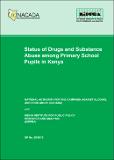| dc.description.abstract | Introduction Studies in Kenya indicate that drugs and substance abuse among young people in learning institutions is a growing social and public health problem. Most of these studies have, however, focused on young persons who are in high school or in higher levels of education (or older than 14 years). This presents a challenge as drug and substance abuse may begin at an earlier age. This scenario has resulted in limited evidence on drugs and substance abuse among primary school pupils. This survey therefore endeavors to assess the level of knowledge, attitudes and use of drugs and substances of abuse among primary school pupils in Kenya. Methodology: A sample of pupils was drawn from 10 stratified regions across the country, broadly divided into: Nairobi, Central, Lower Eastern, Upper Eastern, North Eastern, Coast, Upper Rift, Lower Rift, Nyanza and Western. From the identified regions, 25 representative counties were randomly selected. Using a sampling frame of schools registered with the Ministry of Education, Science and Technology, the schools were categorized into boys, girls, mixed boarding and mixed day schools. A total of 3,307 pupils from 177 randomly selected primary schools were interviewed. The participating pupils were drawn from class 5–8 cohort. Findings: Overall, the survey shows that pupils are fairly knowledgeable on the different drugs and substances of abuse. Tobacco, alcohol and bhang/cannabis were the most widely known drugs with a prevalence of 89.3%, 83.8% and 77.8%, respectively. The drugs and substances of abuse reported as most readily available to primary school pupils were tobacco (41.9%), prescription drugs (27.8%), alcohol (25.9%) and miraa/muguka (23.1%)... | en |

